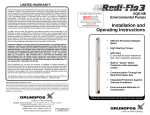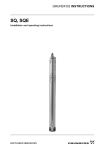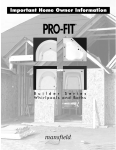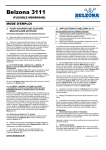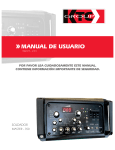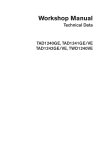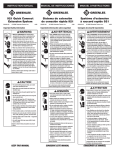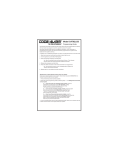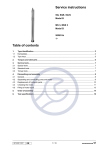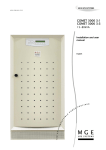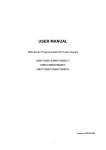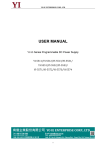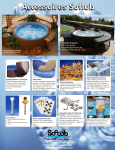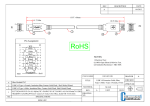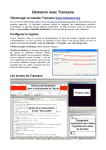Download Grundfos Redi-Flo 3 SQ & SQE Manual
Transcript
LIMITED WARRANTY Products manufactured by GRUNDFOS are warranted to the original user only to be free of defects in material and workmanship for a period of 18 months from date of installation, but not more than 24 months from date of manufacture. GRUNDFOS' liability under this warranty shall be limited to repairing or replacing at GRUNDFOS' option, without charge, F.O.B. GRUNDFOS factory or authorized service station, any product of GRUNDFOS manufacture. GRUNDFOS will not be liable for any costs of removal, installation, transportation, or any other charges which may arise in connection with a warranty claim. Products which are sold but not manufactured by GRUNDFOS are subject to the warranty provided by the manufacturer of said products and not by GRUNDFOS' warranty. GRUNDFOS will not be liable for damage or wear to products caused by abnormal operating conditions, accident, abuse, misuse, unauthorized alteration or repair, or if the product was not installed in accordance with GRUNDFOS printed installation and operating instructions. SQ/SQE Installation and Operating Instructions To obtain service under this warranty, the defective product must be returned to the distributor or dealer of GRUNDFOS products from which it was purchased together with proof of purchase and installation date, failure date, and supporting installation data. Unless otherwise provided, the distributor or dealer will contact GRUNDFOS or an authorized service station for instructions. Any defective product to be returned to GRUNDFOS or a service station must be sent freight prepaid; documentation supporting the warranty claim and/or a Return Material Authorization must be included if so instructed. MANUFACTURER WILL NOT BE LIABLE FOR ANY INCIDENTAL OR CONSEQUENTIAL DAMAGES, LOSSES, OR EXPENSES ARISING FROM INSTALLATION, USE, OR ANY OTHER CAUSES. THERE ARE NO EXPRESS OR IMPLIED WARRANTIES, INCLUDING MERCHANTABILITY OR FITNESS FOR A PARTICULAR PURPOSE, WHICH EXTEND BEYOND THOSE WARRANTIES DESCRIBED OR REFERRED TO ABOVE. EXCEPT AS EXPRESSLY HEREIN PROVIDED THE GOODS ARE SOLD "AS IS", THE ENTIRE RISK AS TO QUALITY AND FITNESS FOR A PARTICULAR PURPOSE, AND PERFORMANCE OF THE GOODS IS WITH THE BUYER, AND SHOULD THE GOODS PROVE DEFECTIVE FOLLOWING THEIR PURCHASE, THE BUYER AND NOT THE MANUFACTURER, DISTRIBUTOR, OR RETAILER ASSUMES THE ENTIRE RISK OF ALL NECESSARY SERVICING OR REPAIR. • High Starting Torque • Soft Start (2 seconds to reach maximum rpm, and maximum pressure) Some jurisdictions do not allow the exclusion or limitation of implied warranties of merchantability and fitness for a particular purpose, of incidental or consequential damages and some jurisdictions do not allow limitations on how long implied warranties may last or require you to pay certain expenses as set forth above. Therefore, the above limitations or exclusions may not apply to you. This warranty gives you specific legal rights and you may also have other rights which vary from jurisdiction to jurisdiction. • Built-in "Smart" Motor Protection with automatic restart The telephone number of our service and repair facilities central directory, from which you can obtain the locations of our service and repair facilities is, 1-800-333-1366. • Simple Installation Federal Communications Commission Notice: This equipment has been tested and found to comply with the limits for a Class A digital device, pursuant to part 15 of the FCC Rules. These limits are designed to provide reasonable protection against harmful interference when the equipment is operated in a commercial environment. This equipment generates, uses, and can radiate radio frequency energy and, if not installed and used in accordance with the instruction manual, may cause harmful interference to radio communications. Operation of this equipment in a residential area is likely to cause harmful interference in which case the user will be required to correct the interference at his own expense. • Communicate with SQE (Through CU300 Status Box) Please leave these instructions with the pump for future reference Grundfos Pumps Corporation • 3131 N. Business Park Ave., Fresno, CA 93727 Customer Service Centers: Allentown, PA • Fresno, CA Phone: (800) 333-1366 • Fax: (800) 333-1363 Canada: Oakville, Ontario • Mexico: Apodaca, N.L. L-SP-TL-017 Rev. 3/30/99 PRINTED IN USA Visit our website at www.us.grundfos.com LIMITED WARRANTY Products manufactured by GRUNDFOS are warranted to the original user only to be free of defects in material and workmanship for a period of 18 months from date of installation, but not more than 24 months from date of manufacture. GRUNDFOS' liability under this warranty shall be limited to repairing or replacing at GRUNDFOS' option, without charge, F.O.B. GRUNDFOS factory or authorized service station, any product of GRUNDFOS manufacture. GRUNDFOS will not be liable for any costs of removal, installation, transportation, or any other charges which may arise in connection with a warranty claim. Products which are sold but not manufactured by GRUNDFOS are subject to the warranty provided by the manufacturer of said products and not by GRUNDFOS' warranty. GRUNDFOS will not be liable for damage or wear to products caused by abnormal operating conditions, accident, abuse, misuse, unauthorized alteration or repair, or if the product was not installed in accordance with GRUNDFOS printed installation and operating instructions. SQ/SQE Installation and Operating Instructions To obtain service under this warranty, the defective product must be returned to the distributor or dealer of GRUNDFOS products from which it was purchased together with proof of purchase and installation date, failure date, and supporting installation data. Unless otherwise provided, the distributor or dealer will contact GRUNDFOS or an authorized service station for instructions. Any defective product to be returned to GRUNDFOS or a service station must be sent freight prepaid; documentation supporting the warranty claim and/or a Return Material Authorization must be included if so instructed. MANUFACTURER WILL NOT BE LIABLE FOR ANY INCIDENTAL OR CONSEQUENTIAL DAMAGES, LOSSES, OR EXPENSES ARISING FROM INSTALLATION, USE, OR ANY OTHER CAUSES. THERE ARE NO EXPRESS OR IMPLIED WARRANTIES, INCLUDING MERCHANTABILITY OR FITNESS FOR A PARTICULAR PURPOSE, WHICH EXTEND BEYOND THOSE WARRANTIES DESCRIBED OR REFERRED TO ABOVE. EXCEPT AS EXPRESSLY HEREIN PROVIDED THE GOODS ARE SOLD "AS IS", THE ENTIRE RISK AS TO QUALITY AND FITNESS FOR A PARTICULAR PURPOSE, AND PERFORMANCE OF THE GOODS IS WITH THE BUYER, AND SHOULD THE GOODS PROVE DEFECTIVE FOLLOWING THEIR PURCHASE, THE BUYER AND NOT THE MANUFACTURER, DISTRIBUTOR, OR RETAILER ASSUMES THE ENTIRE RISK OF ALL NECESSARY SERVICING OR REPAIR. • High Starting Torque • Soft Start (2 seconds to reach maximum rpm, and maximum pressure) Some jurisdictions do not allow the exclusion or limitation of implied warranties of merchantability and fitness for a particular purpose, of incidental or consequential damages and some jurisdictions do not allow limitations on how long implied warranties may last or require you to pay certain expenses as set forth above. Therefore, the above limitations or exclusions may not apply to you. This warranty gives you specific legal rights and you may also have other rights which vary from jurisdiction to jurisdiction. • Built-in "Smart" Motor Protection with automatic restart The telephone number of our service and repair facilities central directory, from which you can obtain the locations of our service and repair facilities is, 1-800-333-1366. • Simple Installation Federal Communications Commission Notice: This equipment has been tested and found to comply with the limits for a Class A digital device, pursuant to part 15 of the FCC Rules. These limits are designed to provide reasonable protection against harmful interference when the equipment is operated in a commercial environment. This equipment generates, uses, and can radiate radio frequency energy and, if not installed and used in accordance with the instruction manual, may cause harmful interference to radio communications. Operation of this equipment in a residential area is likely to cause harmful interference in which case the user will be required to correct the interference at his own expense. • Communicate with SQE (Through CU300 Status Box) Please leave these instructions with the pump for future reference Grundfos Pumps Corporation • 3131 N. Business Park Ave., Fresno, CA 93727 Customer Service Centers: Allentown, PA • Fresno, CA Phone: (800) 333-1366 • Fax: (800) 333-1363 Canada: Oakville, Ontario • Mexico: Apodaca, N.L. L-SP-TL-017 Rev. 3/30/99 PRINTED IN USA Visit our website at www.us.grundfos.com SAFETY Pre-Installation Checklist WARNING Electrical Work WARNING: Reduced risk of electric shock during operation of this pump requires the provision of acceptable grounding. If the means of connection to the supply connected box is other than grounded metal conduit, ground the pump back to the service by connecting a copper conductor (at least the size of the circuit supplying the pump) to the grounding screw provided within the wiring compartment. Pre-Installation Checklist 1. Well Preparation If the pump is to be installed in a new well then the well should be fully developed and bailed or blown free of cuttings and sand. The construction of the GRUNDFOS SQ/SQE submersibles makes it resistant to abrasion; however, no pump made of any material can forever withstand the destructive wear that occurs when constantly pumping sandy water. If this pump is used to replace an oil-filled submersible or oil-lubricated line-shaft turbine in an existing well, the well must be blown or bailed clear of oil. 2. Make Sure You Have the Right Pump Determine the maximum depth of the well, and the drawdown level at the pump's maximum capacity. Pump selection and setting depth should be made based on this data. 3. Pumped Fluid Requirements Submersible well pumps are designed for pumping clear, cold water; free of air or gases. Decreased pump performance and life expectancy can occur if the water is not clear, cold or contains air or gases. Water temperature should not exceed 104°F. Min. 0.5 f/s Pump dia. 5. Applications Typical applications: Groundwater supply for Fig. 2 - residential housing. - small waterworks. - irrigation systems. - liquid transfer in tanks. Note: The pump must not be used as a booster pump in a booster system. GRUNDFOS MS 3 and MSE 3 submersible motors have water-lubricated slide bearings. No additional lubrication is required. I.D. The submersible motors are factory-filled with a special GRUNDFOS motor liquid (type SML 2), which will protect the motor fluid down to -4°F(20°C) and to prevent the growth of bacteria. The level of motor fluid is important for the operating life of the bearings and consequently the life of the motor. Fig. 1 To ensure proper motor cooling refer to the table below for minimum flow requirements: Flow velocity Maximum past the motor liquid temperature 0.0 f/s 86° F(30°C) (free convection) Page 1 Well Dia. 6. Motor Preparation A check should be made to ensure that the installation depth of the pump will always be at least three feet below the maximum drawdown level of the well. The bottom of the motor should never be installed lower than the top the screen or within five feet of the well bottom, as shown in fig.1. 4. Motor Cooling Requirements If the pump is to be installed horizontally, e.g. in a tank, and there is a risk that the pump might be covered by mud, it must be installed in a flow sleeve. Liquid temperatures/cooling Figure 2 shows an SQ/SQE pump installed in a well. With the pump operating. Figure 2 illustrates the following: - Well diameter. - Pump diameter. - Temperature of pumped liquid. - Flow past the motor to the pump suction strainer. Note: The well diameter must be at least 3”. If there is a risk that the motor will be covered with sediment then it is recommended the pump be placed in a Flow Sleeve. The motor should always be installed above the well screen. Refilling of motor liquid It is recommended to refill the motor with GRUNDFOS motor fluid SML 2. 104°F (40°C) Page 2 SAFETY Pre-Installation Checklist WARNING Electrical Work WARNING: Reduced risk of electric shock during operation of this pump requires the provision of acceptable grounding. If the means of connection to the supply connected box is other than grounded metal conduit, ground the pump back to the service by connecting a copper conductor (at least the size of the circuit supplying the pump) to the grounding screw provided within the wiring compartment. Pre-Installation Checklist 1. Well Preparation If the pump is to be installed in a new well then the well should be fully developed and bailed or blown free of cuttings and sand. The construction of the GRUNDFOS SQ/SQE submersibles makes it resistant to abrasion; however, no pump made of any material can forever withstand the destructive wear that occurs when constantly pumping sandy water. If this pump is used to replace an oil-filled submersible or oil-lubricated line-shaft turbine in an existing well, the well must be blown or bailed clear of oil. 2. Make Sure You Have the Right Pump Determine the maximum depth of the well, and the drawdown level at the pump's maximum capacity. Pump selection and setting depth should be made based on this data. 3. Pumped Fluid Requirements Submersible well pumps are designed for pumping clear, cold water; free of air or gases. Decreased pump performance and life expectancy can occur if the water is not clear, cold or contains air or gases. Water temperature should not exceed 104°F. Min. 0.5 f/s Pump dia. 5. Applications Typical applications: Groundwater supply for Fig. 2 - residential housing. - small waterworks. - irrigation systems. - liquid transfer in tanks. Note: The pump must not be used as a booster pump in a booster system. GRUNDFOS MS 3 and MSE 3 submersible motors have water-lubricated slide bearings. No additional lubrication is required. I.D. The submersible motors are factory-filled with a special GRUNDFOS motor liquid (type SML 2), which will protect the motor fluid down to -4°F(20°C) and to prevent the growth of bacteria. The level of motor fluid is important for the operating life of the bearings and consequently the life of the motor. Fig. 1 To ensure proper motor cooling refer to the table below for minimum flow requirements: Flow velocity Maximum past the motor liquid temperature 0.0 f/s 86° F(30°C) (free convection) Page 1 Well Dia. 6. Motor Preparation A check should be made to ensure that the installation depth of the pump will always be at least three feet below the maximum drawdown level of the well. The bottom of the motor should never be installed lower than the top the screen or within five feet of the well bottom, as shown in fig.1. 4. Motor Cooling Requirements If the pump is to be installed horizontally, e.g. in a tank, and there is a risk that the pump might be covered by mud, it must be installed in a flow sleeve. Liquid temperatures/cooling Figure 2 shows an SQ/SQE pump installed in a well. With the pump operating. Figure 2 illustrates the following: - Well diameter. - Pump diameter. - Temperature of pumped liquid. - Flow past the motor to the pump suction strainer. Note: The well diameter must be at least 3”. If there is a risk that the motor will be covered with sediment then it is recommended the pump be placed in a Flow Sleeve. The motor should always be installed above the well screen. Refilling of motor liquid It is recommended to refill the motor with GRUNDFOS motor fluid SML 2. 104°F (40°C) Page 2 Pre-Installation Checklist Installation Procedures To refill the motor, proceed as follows: 8. Electrical connection 1. Remove the cable guard and separate the pump end from the motor. Filling plug 2. Place the motor in vertical position with an inclination of approx. 10°. 3. Remove the filling plug using a screwdriver or a similar tool. General The electrical connection should be carried out by an authorized electrician in accordance with local regulations. Before starting work on the pump, make sure the electricity supply has been switched off and that it cannot be accidentally switched on. The pump must be grounded. The pump must be connected to an external mains switch. 6. Replace the filling plug and make sure it is tight. The supply voltage, rated maximum current and power factor (PF) appear on the motor nameplate. The required voltage for GRUNDFOS submersible MS3/MSE3 motors, measured at the motor terminals, is +6%/–10% of the nominal voltage during continuous operation (including variation in the supply voltage and losses in cables). If the pump is connected to an installation where a Ground Fault circuit breaker (GFI) is used as additional protection, this circuit breaker must trip out when ground fault currents with DC content (pulsating DC) occur. 7. Assemble pump end and motor. Supply voltage:1 x 100-115V or 1 x 200-240 V +6%/–10%, 50/60 Hz. 8. Install the cable guard. The current consumption can only accurately be measured by means of a true RMS instrument. If other instruments are used, the value measured will differ from the actual value. The SQE pumps can be connected to a CU 300 status box. 4. Inject motor liquid into the motor with a filling syringe or similar tool,see fig. 3. 5. To allow possible air to escape, move the motor from side to side. And turn the shaft. Fig. 3 The pump is now ready for installation. 7. Installation Postions Positional requirements The pump is suitable for vertical as well as horizontal installation, however, the pump shaft must never fall below the horizontal plane, see fig. 4. Note: The pump must never be connected to a capacitor or to another type of control box other than a CU 300. The pump must never be connected to an external frequency converter. Motor protection The motor has built-in automatic thermal overload protection and requires no additional motor protection. Connection of motor The motor can be connected directly to the main circuit breaker. Start/stop of the pump will typically be done via a pressure switch, see fig. 5. Note: The pressure switch must be rated for the maximum amps of the specific pump size. Fig. 4 Page 3 Page 4 Pre-Installation Checklist Installation Procedures To refill the motor, proceed as follows: 8. Electrical connection 1. Remove the cable guard and separate the pump end from the motor. Filling plug 2. Place the motor in vertical position with an inclination of approx. 10°. 3. Remove the filling plug using a screwdriver or a similar tool. General The electrical connection should be carried out by an authorized electrician in accordance with local regulations. Before starting work on the pump, make sure the electricity supply has been switched off and that it cannot be accidentally switched on. The pump must be grounded. The pump must be connected to an external mains switch. 6. Replace the filling plug and make sure it is tight. The supply voltage, rated maximum current and power factor (PF) appear on the motor nameplate. The required voltage for GRUNDFOS submersible MS3/MSE3 motors, measured at the motor terminals, is +6%/–10% of the nominal voltage during continuous operation (including variation in the supply voltage and losses in cables). If the pump is connected to an installation where a Ground Fault circuit breaker (GFI) is used as additional protection, this circuit breaker must trip out when ground fault currents with DC content (pulsating DC) occur. 7. Assemble pump end and motor. Supply voltage:1 x 100-115V or 1 x 200-240 V +6%/–10%, 50/60 Hz. 8. Install the cable guard. The current consumption can only accurately be measured by means of a true RMS instrument. If other instruments are used, the value measured will differ from the actual value. The SQE pumps can be connected to a CU 300 status box. 4. Inject motor liquid into the motor with a filling syringe or similar tool,see fig. 3. 5. To allow possible air to escape, move the motor from side to side. And turn the shaft. Fig. 3 The pump is now ready for installation. 7. Installation Postions Positional requirements The pump is suitable for vertical as well as horizontal installation, however, the pump shaft must never fall below the horizontal plane, see fig. 4. Note: The pump must never be connected to a capacitor or to another type of control box other than a CU 300. The pump must never be connected to an external frequency converter. Motor protection The motor has built-in automatic thermal overload protection and requires no additional motor protection. Connection of motor The motor can be connected directly to the main circuit breaker. Start/stop of the pump will typically be done via a pressure switch, see fig. 5. Note: The pressure switch must be rated for the maximum amps of the specific pump size. Fig. 4 Page 3 Page 4 Installation Procedures Installation Procedures 9. Making the Wiring Connections 10. Cable Sizing SINGLE-PHASE WARNING! Reduced risk of electric shock during operation of this pump requires the provision of acceptable grounding. If the means of connection to the supply connected box is other than grounded metal conduit, ground the pump back to the service by connecting a copper conductor, at least the size of the circuit supplying the pump. Motor Rating 10 2- Wire Pump with Ground Quick Disconnect Pressure Switch Black Black Green Pump & Motor Maximum Cable Length Motor Service to Entrance Copper Wire Size VOLTS HP 14 12 10 8 6 4 2 0 115 1/3 1/2 1/3 1/2 3/4 130 100 550 400 300 250 190 210 160 880 650 480 400 310 340 250 1390 1020 760 630 480 540 390 2190 1610 1200 990 770 840 620 3400 2510 1870 1540 1200 1300 960 5250 3880 2890 2380 1870 1960 1460 7960 5880 4370 3610 2850 2910 2160 230 1 1 1/2 Single-Phase 2-wire Wiring Diagram for GRUNDFOS Motors 60 HZ 6470 5360 4280 00 6520 5240 11. Splicing the Cable Splice the drop cable with the motor cable. If the splice is carefully made, it will be as efficient as any other portion of the cable and will be completely watertight. There are a number of cable splicing kits available today - epoxy filled, rubber-sealed, etc. Many perform well if the manufacturer's directions are followed carefully. If one of these kits is not used, we recommend the following method for splicing the motor cable to the drop cable: Examine the motor cable and the drop cable carefully for damage. Cut the motor leads off in a staggered manner. Cut the ends of the drop cable so that the ends match up with the motor leads. Be sure to match the colors. Strip back and strip off one-inch of insulation from each lead, making sure to scrape the wire bare to obtain a good connection. Be careful not to damage the copper conductor when stripping off the insulation. Insert a properly sized Sta-Kon-type connector on each pair of leads, again making sure that colors are matched. Using Sta-Kon crimping pliers, indent the lugs. Be sure to squeeze down hard on the pliers, particularly when using large cable. Form a piece of electrical putty tightly around each Sta-Kon. The putty should overlap on the insulation of the wire. A capacitor or control box should NEVER be connected to a SQ/SQE submersible pump Fig. 5 Page 5 Use a good quality tape such as #33 Scotch Waterproof or Plymouth Rubber Company Slipknot Grey. Wrap each wire and joint tightly for a distance of about 2½ inches on each side of the joint. Make a minimum of four passes over each joint and overlap each pass approximately one inch to assure a completely watertight seal. Page 6 Installation Procedures Installation Procedures 9. Making the Wiring Connections 10. Cable Sizing SINGLE-PHASE WARNING! Reduced risk of electric shock during operation of this pump requires the provision of acceptable grounding. If the means of connection to the supply connected box is other than grounded metal conduit, ground the pump back to the service by connecting a copper conductor, at least the size of the circuit supplying the pump. Motor Rating 10 2- Wire Pump with Ground Quick Disconnect Pressure Switch Black Black Green Pump & Motor Maximum Cable Length Motor Service to Entrance Copper Wire Size VOLTS HP 14 12 10 8 6 4 2 0 115 1/3 1/2 1/3 1/2 3/4 130 100 550 400 300 250 190 210 160 880 650 480 400 310 340 250 1390 1020 760 630 480 540 390 2190 1610 1200 990 770 840 620 3400 2510 1870 1540 1200 1300 960 5250 3880 2890 2380 1870 1960 1460 7960 5880 4370 3610 2850 2910 2160 230 1 1 1/2 Single-Phase 2-wire Wiring Diagram for GRUNDFOS Motors 60 HZ 6470 5360 4280 00 6520 5240 11. Splicing the Cable Splice the drop cable with the motor cable. If the splice is carefully made, it will be as efficient as any other portion of the cable and will be completely watertight. There are a number of cable splicing kits available today - epoxy filled, rubber-sealed, etc. Many perform well if the manufacturer's directions are followed carefully. If one of these kits is not used, we recommend the following method for splicing the motor cable to the drop cable: Examine the motor cable and the drop cable carefully for damage. Cut the motor leads off in a staggered manner. Cut the ends of the drop cable so that the ends match up with the motor leads. Be sure to match the colors. Strip back and strip off one-inch of insulation from each lead, making sure to scrape the wire bare to obtain a good connection. Be careful not to damage the copper conductor when stripping off the insulation. Insert a properly sized Sta-Kon-type connector on each pair of leads, again making sure that colors are matched. Using Sta-Kon crimping pliers, indent the lugs. Be sure to squeeze down hard on the pliers, particularly when using large cable. Form a piece of electrical putty tightly around each Sta-Kon. The putty should overlap on the insulation of the wire. A capacitor or control box should NEVER be connected to a SQ/SQE submersible pump Fig. 5 Page 5 Use a good quality tape such as #33 Scotch Waterproof or Plymouth Rubber Company Slipknot Grey. Wrap each wire and joint tightly for a distance of about 2½ inches on each side of the joint. Make a minimum of four passes over each joint and overlap each pass approximately one inch to assure a completely watertight seal. Page 6 Installation Procedures Installation Procedures General Note: Do not lower or lift the pump by means of the motor cable. 14. Piping • The pump should only be gripped by the two flats at the top of the pump, as shown in fig. 9. • The pump can be installed vertically or horizontally. During operation, the pump must always be completely submerged in water. • When plastic pipe is used, a stainless steel safety wire is recommended for lowering and lifting the pump. Fasten the wire to the eyelet on the pump, as shown in fig. 10. • The threaded joints must be well cut and fit together tightly to ensure that they do not work loose. The loose data plate supplied with the pump should be placed close to the installation site. 12. Installing the cable plug to the motor The cable plug supplied with the motor is factorygreased. Check that the plug is greased correctly. To install the cable plug, proceed as follows: 1.Check that the cable is of the correct type, cross-section and length. 2.Check that the mains on the location has correct connection to ground. 3.Check that the motor socket is clean and dry. 4.Press the cable plug into the motor socket. The plug will only fit one way, see fig. 6. 5.Install and tighten the four nuts, see fig. 6. When the plug has been installed, there must not be a clearance between the motor and the cable plug. Fig. 6 Fig. 9 15. Installing the Pump Fig. 10 Installation Depth The dynamic water level should always be above the pump see fig. 11. 13. Installing the cable guard A = Dynamic water level B = Static Water Level C = Minimum 3" well diameter D = Drawdown E = Installation depth below static water level. Maximum 500 feet To fit the cable guard, proceed as follows: 1. Make sure that the motor lead lies flat in the cable guard. 2. The two flaps of the cable guard must engage with the upper edge of the pump sleeve, see fig. 7. A B D Procedures To install the pump, follow these steps: E 1. Install the enclosed data plate sticker at the well head. Fig. 7 3. Fasten the cable guard to the cable plug with the four screws supplied, see fig. 8. 2. Check the well for proper clearance — the well must be at least 3" in diameter. It is a good idea to check the well for clearance using a plumb ring (2.95 ø x 10 in.). 3. Attach the first section of riser pipe to the pump. C Fig. 11 Fig. 8 Page 7 Page 8 Installation Procedures Installation Procedures General Note: Do not lower or lift the pump by means of the motor cable. 14. Piping • The pump should only be gripped by the two flats at the top of the pump, as shown in fig. 9. • The pump can be installed vertically or horizontally. During operation, the pump must always be completely submerged in water. • When plastic pipe is used, a stainless steel safety wire is recommended for lowering and lifting the pump. Fasten the wire to the eyelet on the pump, as shown in fig. 10. • The threaded joints must be well cut and fit together tightly to ensure that they do not work loose. The loose data plate supplied with the pump should be placed close to the installation site. 12. Installing the cable plug to the motor The cable plug supplied with the motor is factorygreased. Check that the plug is greased correctly. To install the cable plug, proceed as follows: 1.Check that the cable is of the correct type, cross-section and length. 2.Check that the mains on the location has correct connection to ground. 3.Check that the motor socket is clean and dry. 4.Press the cable plug into the motor socket. The plug will only fit one way, see fig. 6. 5.Install and tighten the four nuts, see fig. 6. When the plug has been installed, there must not be a clearance between the motor and the cable plug. Fig. 6 Fig. 9 15. Installing the Pump Fig. 10 Installation Depth The dynamic water level should always be above the pump see fig. 11. 13. Installing the cable guard A = Dynamic water level B = Static Water Level C = Minimum 3" well diameter D = Drawdown E = Installation depth below static water level. Maximum 500 feet To fit the cable guard, proceed as follows: 1. Make sure that the motor lead lies flat in the cable guard. 2. The two flaps of the cable guard must engage with the upper edge of the pump sleeve, see fig. 7. A B D Procedures To install the pump, follow these steps: E 1. Install the enclosed data plate sticker at the well head. Fig. 7 3. Fasten the cable guard to the cable plug with the four screws supplied, see fig. 8. 2. Check the well for proper clearance — the well must be at least 3" in diameter. It is a good idea to check the well for clearance using a plumb ring (2.95 ø x 10 in.). 3. Attach the first section of riser pipe to the pump. C Fig. 11 Fig. 8 Page 7 Page 8 Installation Procedures Operating the Pump 16. Installing the Pump(cont.) 4. Lower the pump into the well. Make sure the motor cable is not damaged when the pump is lifted or lowered into the well — especially in 3" wells. NOTE: Do not lower or lift the pump using the motor cable. 5. When the pump has been installed to the required depth, the installation should be finished by means of a well seal. Note that the dynamic water level should always be above the pump. 6. Loosen the safety wire so that it becomes unloaded and lock it to the well seal using a cable clamp. 7. Attach the supplemental information label at the electrical installation site. 8. Complete the electrical connections. Remember that a capacitor or a control box should NEVER be connected to a SQ/SQE submersible pump. Installation depths Maximum installation depth: below the static water level: 500 feet, Minimum installation depths: 1.75' below the dynamic water level: Vertical installation: During start-up and operation, the pump must always be completely submerged in water. Horizontal installation: The pump must be installed at least 1.75 ft. below the dynamic water level. If there is a risk that the pump might be covered by mud, the pump must always be placed in a flow sleeve. Note: Do not lower or lift the pump with the motor cable. 17. Generator Operation • It is OK to operate the SQ/SQE with a generator. The generator must be sized 10% above the pumps P1 (Input Power) values. Motor HP 1/3 - 1/2 A 1/2 - 3/4 B 1- 11/2 C Page 9 18. Starting the Pump for the First Time When the pump has been connected correctly, the pump should be started with the discharge valve closed approximately one-third. Due to the soft start feature, the pump takes approximately 2 seconds to develop full pressure. Motor Cooling and Other Considerations • Make sure the well is capable of yielding a minimum quantity of water corresponding to the pump capacity. • Do not start the pump until it is completely submerged in the liquid. • As the valve is being opened, the drawdown should be checked to ensure that the pump always remains submerged. • To ensure the necessary cooling of the motor, the pump should never be set so low that it gives no water. If the flow rate suddenly falls, the reason might be that the pump is pumping more water than the well can yield. The pump must immediately be stopped and the fault remedied. Water Impurities • If there are impurities in the water, the valve should be opened gradually as the water becomes clearer. The pump should not be stopped until the water is clean, otherwise the pump parts and the check valve may become clogged. • When the water is clean the valve should be fully opened. Minimum flow rate • To ensure the necessary cooling of the motor, the pump flow rate should never be set to a value lower than .2 gpm. If the flow rate suddenly falls, the reason might be that the pump is pumping more water than the well can yield. The pump must be stopped and the fault corrected. Note: The pump's dry-running protection is effective only within the recommended duty range of the pump. Note: Do not let the pump run against a closed discharge valve for more than 5 minutes. When the discharge valve is closed, there is no cooling flow and there is a risk of overheating in motor and pump. Min. Generator Size (Watts) 1000 1700 2000 Page 10 Installation Procedures Operating the Pump 16. Installing the Pump(cont.) 4. Lower the pump into the well. Make sure the motor cable is not damaged when the pump is lifted or lowered into the well — especially in 3" wells. NOTE: Do not lower or lift the pump using the motor cable. 5. When the pump has been installed to the required depth, the installation should be finished by means of a well seal. Note that the dynamic water level should always be above the pump. 6. Loosen the safety wire so that it becomes unloaded and lock it to the well seal using a cable clamp. 7. Attach the supplemental information label at the electrical installation site. 8. Complete the electrical connections. Remember that a capacitor or a control box should NEVER be connected to a SQ/SQE submersible pump. Installation depths Maximum installation depth: below the static water level: 500 feet, Minimum installation depths: 1.75' below the dynamic water level: Vertical installation: During start-up and operation, the pump must always be completely submerged in water. Horizontal installation: The pump must be installed at least 1.75 ft. below the dynamic water level. If there is a risk that the pump might be covered by mud, the pump must always be placed in a flow sleeve. Note: Do not lower or lift the pump with the motor cable. 17. Generator Operation • It is OK to operate the SQ/SQE with a generator. The generator must be sized 10% above the pumps P1 (Input Power) values. Motor HP 1/3 - 1/2 A 1/2 - 3/4 B 1- 11/2 C Page 9 18. Starting the Pump for the First Time When the pump has been connected correctly, the pump should be started with the discharge valve closed approximately one-third. Due to the soft start feature, the pump takes approximately 2 seconds to develop full pressure. Motor Cooling and Other Considerations • Make sure the well is capable of yielding a minimum quantity of water corresponding to the pump capacity. • Do not start the pump until it is completely submerged in the liquid. • As the valve is being opened, the drawdown should be checked to ensure that the pump always remains submerged. • To ensure the necessary cooling of the motor, the pump should never be set so low that it gives no water. If the flow rate suddenly falls, the reason might be that the pump is pumping more water than the well can yield. The pump must immediately be stopped and the fault remedied. Water Impurities • If there are impurities in the water, the valve should be opened gradually as the water becomes clearer. The pump should not be stopped until the water is clean, otherwise the pump parts and the check valve may become clogged. • When the water is clean the valve should be fully opened. Minimum flow rate • To ensure the necessary cooling of the motor, the pump flow rate should never be set to a value lower than .2 gpm. If the flow rate suddenly falls, the reason might be that the pump is pumping more water than the well can yield. The pump must be stopped and the fault corrected. Note: The pump's dry-running protection is effective only within the recommended duty range of the pump. Note: Do not let the pump run against a closed discharge valve for more than 5 minutes. When the discharge valve is closed, there is no cooling flow and there is a risk of overheating in motor and pump. Min. Generator Size (Watts) 1000 1700 2000 Page 10 Assembly/Disassembly Operating the Pump Built-in protection The motor incorporates an electronic unit which protects the motor in various situations. In case of overload, the built-in overload protection will stop the pump for 5 minutes. After that period, the pump will attempt to restart. If the pump is started and the well has not recovered, the pump will stop after 30 seconds. If the pump has been stopped as a result of dry running, it will start automatically after 5 minutes. Resetting the pump: Switch off the electricity supply for 1 minute. The motor is protected against the following conditions: - dry running, - voltage surges (up to 5000 V), - overvoltage, - undervoltage, - overload - overtemperature. 19. Assembly of Pump and Motor To assemble pump end and motor, proceed as follows: 1. Place the motor horizontally in a vice and tighten it, see fig. 12. 2. Grease the motor shaft end with the grease supplied with the motor. 3. Screw the pump end on the motor. A spanner may be used on the clamping faces of the pump part, see fig.12. 4. Install cable guard as described on page 7. When pump end and motor have been assembled correctly, there must not be a clearance between pump end and motor. To disassemble reverse procedure. MS 3 Motors: Note: All MS 3 motors are factory set to detect dry running conditions. However, it is important to ensure that the configurations of both the SQ pump and motor are the same configuration. Configurations can be found on both SQ pump and motor nameplates as “ Config.” EXAMPLE: Config. A-2, must match the other nameplate A-2. See Technical Data on page 17 for quick referencing on all configurations. MSE 3 Motors: Note: To set Dry-Run limit in the MSE/SQE pumps, you need to connect the pump to a CU 300. Refer to CU 300 I&O for proper connections. To set Dry-Run protection, follow these steps: 1. Start the pump against closed discharge. 2. Rapidly read the power consumption value (W) in the R100 display 2.5. 3. Multiply this value by 0.9. 4. Within the R100, go to display 4.6 and enter the new value (minimum power limit). 5. Go to display 4.7 and change the setting to “Active”. For further information on dry-running, refer to CU 300 I&O. Maintenance and service: The pumps are normally maintenance-free. Deposits and wear may occur. For that purpose, service kits and service tools are available from GRUNDFOS. The GRUNDFOS Service Manual is available on request. The pumps can be serviced at a GRUNDFOS service center. Page 11 Use pump vise here. 2.91" 70 mm 301.2" mm Fig. 12 Page 12 Assembly/Disassembly Operating the Pump Built-in protection The motor incorporates an electronic unit which protects the motor in various situations. In case of overload, the built-in overload protection will stop the pump for 5 minutes. After that period, the pump will attempt to restart. If the pump is started and the well has not recovered, the pump will stop after 30 seconds. If the pump has been stopped as a result of dry running, it will start automatically after 5 minutes. Resetting the pump: Switch off the electricity supply for 1 minute. The motor is protected against the following conditions: - dry running, - voltage surges (up to 5000 V), - overvoltage, - undervoltage, - overload - overtemperature. 19. Assembly of Pump and Motor To assemble pump end and motor, proceed as follows: 1. Place the motor horizontally in a vice and tighten it, see fig. 12. 2. Grease the motor shaft end with the grease supplied with the motor. 3. Screw the pump end on the motor. A spanner may be used on the clamping faces of the pump part, see fig.12. 4. Install cable guard as described on page 7. When pump end and motor have been assembled correctly, there must not be a clearance between pump end and motor. To disassemble reverse procedure. MS 3 Motors: Note: All MS 3 motors are factory set to detect dry running conditions. However, it is important to ensure that the configurations of both the SQ pump and motor are the same configuration. Configurations can be found on both SQ pump and motor nameplates as “ Config.” EXAMPLE: Config. A-2, must match the other nameplate A-2. See Technical Data on page 17 for quick referencing on all configurations. MSE 3 Motors: Note: To set Dry-Run limit in the MSE/SQE pumps, you need to connect the pump to a CU 300. Refer to CU 300 I&O for proper connections. To set Dry-Run protection, follow these steps: 1. Start the pump against closed discharge. 2. Rapidly read the power consumption value (W) in the R100 display 2.5. 3. Multiply this value by 0.9. 4. Within the R100, go to display 4.6 and enter the new value (minimum power limit). 5. Go to display 4.7 and change the setting to “Active”. For further information on dry-running, refer to CU 300 I&O. Maintenance and service: The pumps are normally maintenance-free. Deposits and wear may occur. For that purpose, service kits and service tools are available from GRUNDFOS. The GRUNDFOS Service Manual is available on request. The pumps can be serviced at a GRUNDFOS service center. Page 11 Use pump vise here. 2.91" 70 mm 301.2" mm Fig. 12 Page 12 Troubleshooting Fault 1. The pump does not run 2. The pump runs but gives no water. 3. The pump runs at reduced capacity. 4. Frequent starts and stops. Troubleshooting Cause a. The fuses are blown b. The GFI circuit breaker has tripped. c. No electricity supply. d. The motor protection has cut off the electricity supply due to overload. e. The drop cable is defective. f. Overvoltage has occured. a. The discharge is closed. b. No water or too low water level in well. c. Check valve is stuck in it’s closed position. d. The suction strainer is closed. e. The pump is defective. a. The drawdown is larger than anticipated. b. The valve s in the discharge pipe are partly closed/blocked. c. The discharge pipe is partly chocked by impurities (Iron bacteria). d. The non- return valve of the pump is blocked. e. The pump and the riser pipe are partly choked by impurities (Iron bacteria). f. The pump is defective. g. Hole in discharge pipe. h. The riser pipe is defective. i. Undervoltage has occurred. a. The differential of the pressure switch between the start and stop pressures is too small. b. The water level electrodes or level switches in the reservior have not been installed correctly c. Checkvalve is leaking or stuck half-open. d. The supply voltage is unstable. e. The motor temperature is too high. Page 13 Remedy Replace the blown fuses. If the new fuses blow too, check the electrical installation and the drop cable. Reset the circuit breaker. Contact the Electricity provider. Check for motor/pump blockage. Repair/replace the pump/cable. Check the electricity supply Open the valve See item 3a. Pull the pump and clean or replace the valve. Pull the pump and clean the strainer. Repair/replace the pump. Increase the installation depth of the pump, throttle the pump or replace it with a smaller capacity model. Check and clean/replace the valves as necessary. Clean/rplace the dischrge pipe. Pull the pump and check/replace the valve. Pull out the pump. Check and clean or replace the pump, if necessary. Clean the pipes. Repair/replace the pump. Check and repair the piping. Replace. Check the electricity supply. Increase the differential. However, the stop pressure must not exceed the operating pressure of the pressure tank, and the start pressure should be high enough to ensure sufficient water supply. Adjust the intervals of the electrodes/level switches to ensure suitable time between the cutting-in and cutting-out of the pump. See installation and operating instructions for the automatic devices used. If the intervals between start/stop cannot be changed via the automatics, the pump capacity may be reduced by throttling the discharge valve. Pull the pump and clean/replace the non-return valve. Check the electrical supply. Check the water temperature. Page 14 Troubleshooting Fault 1. The pump does not run 2. The pump runs but gives no water. 3. The pump runs at reduced capacity. 4. Frequent starts and stops. Troubleshooting Cause a. The fuses are blown b. The GFI circuit breaker has tripped. c. No electricity supply. d. The motor protection has cut off the electricity supply due to overload. e. The drop cable is defective. f. Overvoltage has occured. a. The discharge is closed. b. No water or too low water level in well. c. Check valve is stuck in it’s closed position. d. The suction strainer is closed. e. The pump is defective. a. The drawdown is larger than anticipated. b. The valve s in the discharge pipe are partly closed/blocked. c. The discharge pipe is partly chocked by impurities (Iron bacteria). d. The non- return valve of the pump is blocked. e. The pump and the riser pipe are partly choked by impurities (Iron bacteria). f. The pump is defective. g. Hole in discharge pipe. h. The riser pipe is defective. i. Undervoltage has occurred. a. The differential of the pressure switch between the start and stop pressures is too small. b. The water level electrodes or level switches in the reservior have not been installed correctly c. Checkvalve is leaking or stuck half-open. d. The supply voltage is unstable. e. The motor temperature is too high. Page 13 Remedy Replace the blown fuses. If the new fuses blow too, check the electrical installation and the drop cable. Reset the circuit breaker. Contact the Electricity provider. Check for motor/pump blockage. Repair/replace the pump/cable. Check the electricity supply Open the valve See item 3a. Pull the pump and clean or replace the valve. Pull the pump and clean the strainer. Repair/replace the pump. Increase the installation depth of the pump, throttle the pump or replace it with a smaller capacity model. Check and clean/replace the valves as necessary. Clean/rplace the dischrge pipe. Pull the pump and check/replace the valve. Pull out the pump. Check and clean or replace the pump, if necessary. Clean the pipes. Repair/replace the pump. Check and repair the piping. Replace. Check the electricity supply. Increase the differential. However, the stop pressure must not exceed the operating pressure of the pressure tank, and the start pressure should be high enough to ensure sufficient water supply. Adjust the intervals of the electrodes/level switches to ensure suitable time between the cutting-in and cutting-out of the pump. See installation and operating instructions for the automatic devices used. If the intervals between start/stop cannot be changed via the automatics, the pump capacity may be reduced by throttling the discharge valve. Pull the pump and clean/replace the non-return valve. Check the electrical supply. Check the water temperature. Page 14 Technical Data Troubleshooting supply Voltage: Instruments not allowed: Note: The use of the following instruments is not allowed during fault finding: Insulation Test Resistance Test High-voltage Test Note: When measuring, use RMS-instruments. Checking the motor and cable: Measure the voltage L1 (RMS) between phase and L2. Connect the voltmeter to the terminals at the connections. Measure the current (RMS) while the pump is operating at a constant discharge head(if possible, at capacity where the motor is heavily loaded). For maximum current, see motor nameplate. The voltage should, when the motor is loaded, be within the range specified on Page 4, large variations in supply voltage indicate poor electricity supply, and the pump should be stopped until the problem has been corrected. If the current exceeds the full load current, there are the following possible faults: Poor connection in the leads, possibly in the cable joint. Too low supply voltage, see item 1 on Page 13. Environment During handling, operation, storage and transport, all environment regulations dealing with the handling of hazardous materials must be observed. When the pump is taken out of operation, it must be ensured that no hazardous material is left in the pump and in the riser pipe, which can be injurous to persons and the environment. Disposal Disposal of this product or parts of it must be carried out according to the following guidelines: 1. Use the local public or private waste collection service. 2. If such waste collection service does not exist or cannot handle the materials used in the product, please deliver the product or any hazardous materials from it to your nearest GRUNDFOS company or service center. Page 15 1x200-240V +6%/-10%, 50/60 Hz, PE 1x100-115V +6%/-10%, 50/60 Hz, PE Operation via Generator: As a minimum, the generator output must be equal to the motor P1[KW] +10% Starting Current: The motor starting current is equal to the highest value stated on the motor nameplate Starting: Soft starting Run-up Time: Maximum : 2 seconds Motor Protection: The motor is protected against: Dry running, overvoltage, undervoltage, overload, overtemperature Power Factor: PF= 1 Service Factor: 0.33-0.50A[HP]-1.75 at 115V/230V 0.50-0.75A[HP]-1.4 at 230V 1.0 -1.5C[HP] -1.15 at 230V Motor Cable: 3 Wire, 14 AWG XLPE Length 5 ft Motor Liquid: Type SML 2 pH Values: SQ and SQE: 5 to 9 Liquid Temperature: The temperature of the pumped liquid must not exceed 104°F. Note: if liquids with a viscosity higher than that of water are to be pumped, please contact GRUNDFOS Discharge Port: 5SQ/SQE- 1"NPT 10-15SQ/SQE- 1 1/4" NPT 22-30SQ/SQE- 1 1/2" NPT STORAGE CONDITIONS Minimum Ambient Temperature: -4°F Maximum Ambient Temperature: +140°F Freeze Protection: If the pump has to be stored after use, it must be stored on a frost-free location or it must be ensured that the motor liquid is frost-proof. (The motor must be stored without being filled with motor liquid.) OPERATING CONDITIONS Minimum Ambient Fluid Temperature: -4°F Maximum Ambient Fluid Temperature: +104°F APPROXIMATE DIMENSIONS AND WEIGHT Motor Dimensions (MS 3 & MSE 3): 0.33-0.50A[hp] 20.9" length x 2.68" diameter 0.50-0.75B[hp] 20.9" length x 2.68" diameter 1.0-1.5C[hp] 22.3" length x 2.68" diameter Motor Weights (MS 3 & MSE 3): 0.33-0.50A[hp] 6.0 Lbs 0.50-0.75B[hp] 7.1 Lbs 1.0-1.5C[hp] 8.2 Lbs Pump End Dimensions: Pump Diameter: 2.68" Pump Diameter, incl. cable guard: 2.91" Pump End Dimensions(min. and max.): 5SQ/SQE 10.6" to 18.0" 10SQ/SQE 10.6" to 16.9" 15SQ/SQE 10.6" to 16.9" 22SQ/SQE 10.6" to 16.9" 30SQ/SQE 10.6" to 13.7" Pump End Weights(min. and max.): All SQ/SQE Models 2.2 lbs to 3.5 lbs Well Diameter (minimum): 3" Installation Depth (Maximum): 500 feet, below static water level. Page 16 Technical Data Troubleshooting supply Voltage: Instruments not allowed: Note: The use of the following instruments is not allowed during fault finding: Insulation Test Resistance Test High-voltage Test Note: When measuring, use RMS-instruments. Checking the motor and cable: Measure the voltage L1 (RMS) between phase and L2. Connect the voltmeter to the terminals at the connections. Measure the current (RMS) while the pump is operating at a constant discharge head(if possible, at capacity where the motor is heavily loaded). For maximum current, see motor nameplate. The voltage should, when the motor is loaded, be within the range specified on Page 4, large variations in supply voltage indicate poor electricity supply, and the pump should be stopped until the problem has been corrected. If the current exceeds the full load current, there are the following possible faults: Poor connection in the leads, possibly in the cable joint. Too low supply voltage, see item 1 on Page 13. Environment During handling, operation, storage and transport, all environment regulations dealing with the handling of hazardous materials must be observed. When the pump is taken out of operation, it must be ensured that no hazardous material is left in the pump and in the riser pipe, which can be injurous to persons and the environment. Disposal Disposal of this product or parts of it must be carried out according to the following guidelines: 1. Use the local public or private waste collection service. 2. If such waste collection service does not exist or cannot handle the materials used in the product, please deliver the product or any hazardous materials from it to your nearest GRUNDFOS company or service center. Page 15 1x200-240V +6%/-10%, 50/60 Hz, PE 1x100-115V +6%/-10%, 50/60 Hz, PE Operation via Generator: As a minimum, the generator output must be equal to the motor P1[KW] +10% Starting Current: The motor starting current is equal to the highest value stated on the motor nameplate Starting: Soft starting Run-up Time: Maximum : 2 seconds Motor Protection: The motor is protected against: Dry running, overvoltage, undervoltage, overload, overtemperature Power Factor: PF= 1 Service Factor: 0.33-0.50A[HP]-1.75 at 115V/230V 0.50-0.75A[HP]-1.4 at 230V 1.0 -1.5C[HP] -1.15 at 230V Motor Cable: 3 Wire, 14 AWG XLPE Length 5 ft Motor Liquid: Type SML 2 pH Values: SQ and SQE: 5 to 9 Liquid Temperature: The temperature of the pumped liquid must not exceed 104°F. Note: if liquids with a viscosity higher than that of water are to be pumped, please contact GRUNDFOS Discharge Port: 5SQ/SQE- 1"NPT 10-15SQ/SQE- 1 1/4" NPT 22-30SQ/SQE- 1 1/2" NPT STORAGE CONDITIONS Minimum Ambient Temperature: -4°F Maximum Ambient Temperature: +140°F Freeze Protection: If the pump has to be stored after use, it must be stored on a frost-free location or it must be ensured that the motor liquid is frost-proof. (The motor must be stored without being filled with motor liquid.) OPERATING CONDITIONS Minimum Ambient Fluid Temperature: -4°F Maximum Ambient Fluid Temperature: +104°F APPROXIMATE DIMENSIONS AND WEIGHT Motor Dimensions (MS 3 & MSE 3): 0.33-0.50A[hp] 20.9" length x 2.68" diameter 0.50-0.75B[hp] 20.9" length x 2.68" diameter 1.0-1.5C[hp] 22.3" length x 2.68" diameter Motor Weights (MS 3 & MSE 3): 0.33-0.50A[hp] 6.0 Lbs 0.50-0.75B[hp] 7.1 Lbs 1.0-1.5C[hp] 8.2 Lbs Pump End Dimensions: Pump Diameter: 2.68" Pump Diameter, incl. cable guard: 2.91" Pump End Dimensions(min. and max.): 5SQ/SQE 10.6" to 18.0" 10SQ/SQE 10.6" to 16.9" 15SQ/SQE 10.6" to 16.9" 22SQ/SQE 10.6" to 16.9" 30SQ/SQE 10.6" to 13.7" Pump End Weights(min. and max.): All SQ/SQE Models 2.2 lbs to 3.5 lbs Well Diameter (minimum): 3" Installation Depth (Maximum): 500 feet, below static water level. Page 16 Technical Data Technical Data HP VOLTAGE CONFIG. 5SQ/SQE03A-90 5SQ/SQE03A-140 5SQ/SQE05A-180 5SQ/SQE05B-230 5SQ/SQE05B-270 5SQ/SQE07B-320 5SQ/SQE10C-360 5SQ/SQE10C-410 5SQ/SQE10C-450 PUMP TYPE 1/3 A 1/3 A 1/2 A 1/2 B 1/2 B 3/4 B 1C 1C 1C 230V/115V 230V/115V 230V/115V 230V 230V 230V 230V 230V 230V A-2 A-4 A-5 B-8 B-9 B-6 C-2 C-10 C-7 3.9/7.8 3.9/7.8 4.9/9.8 4.9 4.9 7.6 7.6 7.6 7.6 10SQ/SQE03A-110 10SQ/SQE05A-160 10SQ/SQE05B-200 10SQ/SQE07B-240 10SQ/SQE10C-290 10SQ/SQE10C-330 10SQ/SQE15C-380 1/3 A 1/2 A 1/2 B 3/4 B 1C 1C 1 1/2 C 230V/115V 230V/115V 230V 230V 230V 230V 230V A-2 A-4 B-3 B-4 C-2 C-9 C-5 3.9/7.8 4.9/9.8 4.9 7.6 7.6 7.6 11.1 15SQ/SQE03A-70 15SQ/SQE05A-110 15SQ/SQE05B-150 15SQ/SQE07B-180 15SQ/SQE10C-220 15SQ/SQE10C-250 15SQ/SQE15C-290 1/3 A 1/2 A 1/2 B 3/4 B 1C 1C 1 1/2 C 230V/115V 230V/115V 230V 230V 230V 230V 230V A-1 A-3 B-1 B-5 C-1 C-3 C-9 3.9/7.8 4.9/9.8 4.9 7.6 7.6 7.6 11.1 22SQ/SQE03A-40 22SQ/SQE05A-80 22SQ/SQE05B-120 22SQ/SQE07B-160 22SQ/SQE10C-190 22SQ/SQE15C-220 1/3 A 1/2 A 1/2 B 3/4 B 1C 1 1/2 C 230V/115V 230V/115V 230V 230V 230V 230V A-7 A-6 B-2 B-5 C-4 C-6 3.9/7.8 4.9/9.8 4.9 7.6 7.6 11.1 30SQ/SQE05A-40 30SQ/SQE05B-90 30SQ/SQE10C-130 30SQ/SQE15C-170 1/2 A 1/2 B 1C 1 1/2 C 230V/115V 230V 230V 230V A-1 B-7 C-8 C-2 4.9/9.8 7.6 7.6 11.1 Page 17 ACCESSORIES MAX. AMPS PRODUCT PART NUMBER CU 300 96422776 FLOW SLEEVE 96037505 GREASE 96037562 FLOW SWITCH .5 GPM 5-15SQE 96022967 FLOW SWITCH 1 GPM 22-30SQE 96022970 PRESSURE TRANSMITTER 96026030 CONSTANT PRESSURE KIT: 5-15SQE 96022968 (Includes CU300, Pressure Transducer & .5 GPM Flow Switch) CONSTANT PRESSURE KIT: 22-30SQE 96022971 (Includes CU300, Pressure Transducer & 1 GPM Flow Switch) Notes Page 18 Technical Data Technical Data HP VOLTAGE CONFIG. 5SQ/SQE03A-90 5SQ/SQE03A-140 5SQ/SQE05A-180 5SQ/SQE05B-230 5SQ/SQE05B-270 5SQ/SQE07B-320 5SQ/SQE10C-360 5SQ/SQE10C-410 5SQ/SQE10C-450 PUMP TYPE 1/3 A 1/3 A 1/2 A 1/2 B 1/2 B 3/4 B 1C 1C 1C 230V/115V 230V/115V 230V/115V 230V 230V 230V 230V 230V 230V A-2 A-4 A-5 B-8 B-9 B-6 C-2 C-10 C-7 3.9/7.8 3.9/7.8 4.9/9.8 4.9 4.9 7.6 7.6 7.6 7.6 10SQ/SQE03A-110 10SQ/SQE05A-160 10SQ/SQE05B-200 10SQ/SQE07B-240 10SQ/SQE10C-290 10SQ/SQE10C-330 10SQ/SQE15C-380 1/3 A 1/2 A 1/2 B 3/4 B 1C 1C 1 1/2 C 230V/115V 230V/115V 230V 230V 230V 230V 230V A-2 A-4 B-3 B-4 C-2 C-9 C-5 3.9/7.8 4.9/9.8 4.9 7.6 7.6 7.6 11.1 15SQ/SQE03A-70 15SQ/SQE05A-110 15SQ/SQE05B-150 15SQ/SQE07B-180 15SQ/SQE10C-220 15SQ/SQE10C-250 15SQ/SQE15C-290 1/3 A 1/2 A 1/2 B 3/4 B 1C 1C 1 1/2 C 230V/115V 230V/115V 230V 230V 230V 230V 230V A-1 A-3 B-1 B-5 C-1 C-3 C-9 3.9/7.8 4.9/9.8 4.9 7.6 7.6 7.6 11.1 22SQ/SQE03A-40 22SQ/SQE05A-80 22SQ/SQE05B-120 22SQ/SQE07B-160 22SQ/SQE10C-190 22SQ/SQE15C-220 1/3 A 1/2 A 1/2 B 3/4 B 1C 1 1/2 C 230V/115V 230V/115V 230V 230V 230V 230V A-7 A-6 B-2 B-5 C-4 C-6 3.9/7.8 4.9/9.8 4.9 7.6 7.6 11.1 30SQ/SQE05A-40 30SQ/SQE05B-90 30SQ/SQE10C-130 30SQ/SQE15C-170 1/2 A 1/2 B 1C 1 1/2 C 230V/115V 230V 230V 230V A-1 B-7 C-8 C-2 4.9/9.8 7.6 7.6 11.1 Page 17 ACCESSORIES MAX. AMPS PRODUCT PART NUMBER CU 300 96422776 FLOW SLEEVE 96037505 GREASE 96037562 FLOW SWITCH .5 GPM 5-15SQE 96022967 FLOW SWITCH 1 GPM 22-30SQE 96022970 PRESSURE TRANSMITTER 96026030 CONSTANT PRESSURE KIT: 5-15SQE 96022968 (Includes CU300, Pressure Transducer & .5 GPM Flow Switch) CONSTANT PRESSURE KIT: 22-30SQE 96022971 (Includes CU300, Pressure Transducer & 1 GPM Flow Switch) Notes Page 18





















